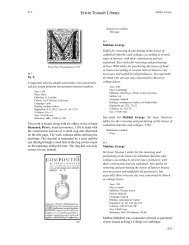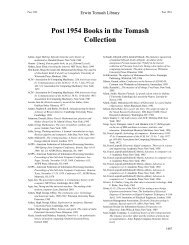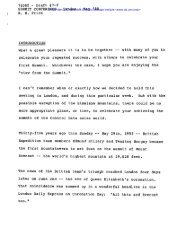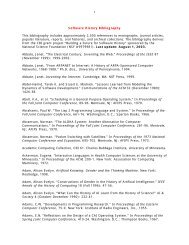B chapter.indd - Charles Babbage Institute - University of Minnesota
B chapter.indd - Charles Babbage Institute - University of Minnesota
B chapter.indd - Charles Babbage Institute - University of Minnesota
Create successful ePaper yourself
Turn your PDF publications into a flip-book with our unique Google optimized e-Paper software.
Erwin Tomash Library<br />
Borghi, Pietro Borghi, Pietro<br />
B 208<br />
The first and last folios contain poems headed by the<br />
initials SDSU (some read it as SHSU), about which there<br />
has been much speculation. Smith seems to think that the<br />
letters S H S U which appear twice are thought to stand<br />
for J H S U, Jesus, possibly changed on account <strong>of</strong> some<br />
conjectured pronunciation.<br />
This work is more elaborate than the Treviso arithmetic<br />
and had far greater influence on education. More than<br />
any other book, it set a standard for the arithmetics <strong>of</strong> the<br />
succeeding century. Borghi first treats notation, carrying<br />
his numbers as high as 1 numero de million de million de<br />
million and making no mention whatever <strong>of</strong> the Roman<br />
numerals. In the same spirit, he eliminates all <strong>of</strong> the<br />
medieval theory <strong>of</strong> numbers, asserting that he does this<br />
because he is preparing a practical book for the use <strong>of</strong><br />
merchants.<br />
The sequence <strong>of</strong> material is unusual because<br />
multiplication is the first operation Borda considers.<br />
This is followed by division, despite the fact that both<br />
<strong>of</strong> these use addition and subtraction. The multiplication<br />
table (see illustration) gives the products <strong>of</strong> all pairs <strong>of</strong><br />
numbers from 1 – 10 but also includes the products <strong>of</strong><br />
12, 16, 20, 24, 32, 36 because they were useful factors<br />
for the currency then in use. The author gives the method<br />
<strong>of</strong> checking by casting out 7s and 9s. Multiplication per<br />
colonna (i.e., by reference to the columns <strong>of</strong> the table)<br />
follows, with its checks by 7 and 9, and per crocetta<br />
(cross multiplication), showing that these methods<br />
were in common use in Venice <strong>of</strong> the day. Division is<br />
then explained by the galley form; our present method,<br />
then known as the method <strong>of</strong> giving, a danda, was<br />
not mentioned. Then follow addition, subtraction,<br />
denominate numbers, common fractions (also beginning<br />
with multiplication), rule <strong>of</strong> three, partnership, barter,<br />
alligation and false position. The examples are generally<br />
practical, and they reveal much information concerning<br />
business customs at the close <strong>of</strong> the fifteenth century.<br />
Illustrations available:<br />
First folio with “SDSU” poem<br />
First page<br />
Multiplication table<br />
Galley division<br />
Last folio with “SDSU” poem and colophon<br />
Division examples, B 208<br />
Multiplication table, B 208<br />
177







